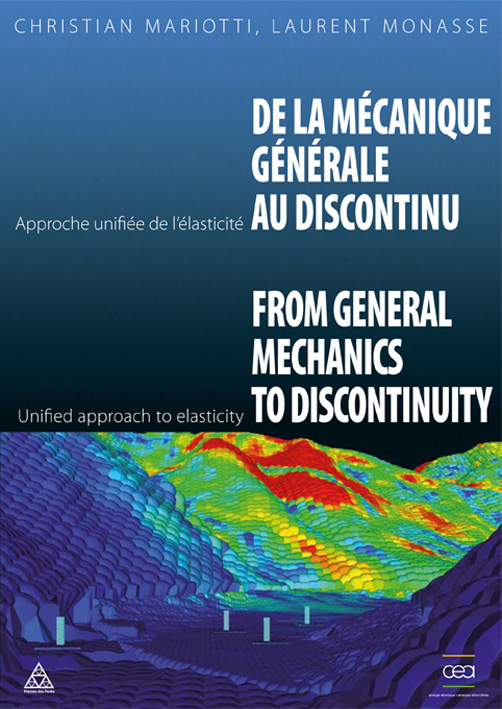Research themes:
Brief curriculum vitae:
2017 - present Researcher, project-team COFFEE then Acumes, Inria Sophia Antipolis and Université Nice Sophia-Antipolis2012 - 2017 Researcher, CERMICS, Ecole des Ponts ParisTech.
2011 - 2012 Post-doc position in Prof. Charbel Farhat's group in Stanford, Aero/Astro department.
2008 - 2011 PhD thesis, CERMICS, Ecole des Ponts ParisTech (manuscript)
Analysis of a Discrete Element Method for structure dynamics and coupling with a compressible fluid flow method.
Advisors: Serge Piperno, Virginie Daru
Detailed CV (pdf format)
Publications
Book:

C. Mariotti and L. Monasse, From general mechanics to discontinuity: Unified approach to elasticity, Presses des Ponts, 2011.
Articles:
- L. Monasse and C. Mariotti, An energy-preserving Discrete Element Method for elastodynamics, ESAIM: Mathematical Modelling and Numerical Analysis 46, pp. 1527-1553, 2012, published version
- L. Monasse, V. Daru, C. Mariotti, S. Piperno, C. Tenaud, A conservative coupling algorithm between a compressible flow and a rigid body using an Embedded Boundary method, Journal of Computational Physics 231, pp. 2977-2994, 2012, final version
- L. Monasse, R. Monneau, Gradient entropy estimate and convergence of a semi-explicit scheme for diagonal hyperbolic systems, SIAM Journal on Numerical Analysis 52:6, pp. 2792-2814, 2014, published version
- M. A. Puscas, L. Monasse, A three-dimensional conservative coupling method between an inviscid compressible flow and a moving rigid solid body, SIAM Journal on Scientific Computing 37, pp. 884-909, 2015, accepted version
- M. A. Puscas, L. Monasse, A. Ern, C. Tenaud, C. Mariotti, V. Daru, A time semi-implicit scheme for the energy-balanced coupling of a shocked fluid flow with a deformable structure, Journal of Computational Physics 296, pp. 241-262, 2015, final version
- M. A. Puscas, L. Monasse, A. Ern, C. Tenaud, C. Mariotti, A conservative embedded boundary method for an inviscid compressible flow coupled with a fragmenting structure, International Journal for Numerical methods in Engineering 103(13), pp. 970-995, 2015, preprint
- Y. Masson, L. Monasse, Existence of global Chebyshev nets on surfaces of absolute Gaussian curvature less than 2π, Journal of Geometry 108(1), pp. 25-32, 2017, doi:10.1007/s00022-016-0319-1, preprint
- T. Jourdan, G. Stoltz, F. Legoll, L. Monasse, An accurate scheme to solve cluster dynamics equations using a Fokker-Planck approach, Computer Physics Communications 207, pp. 170-178, 2016, preprint.
- H. Nassar, A. Lebée, L. Monasse, Curvature, metric and parametrization of origami tessellations: Theory and application to the eggbox pattern, Proceedings of the Royal Society A 473, 2017, doi:10.1098/rspa.2016.0705, preprint.
- J. Ridoux, N. Lardjane, L. Monasse, F. Coulouvrat, Comparison of Geometrical Shock Dynamics and Kinematic models for shock wave propagation, Shock Waves 28(2), pp. 401-416, 2018, preprint.
- J. Ridoux, N. Lardjane, L. Monasse, F. Coulouvrat, Beyond the limitation of geometrical shock dynamics for diffraction over wedges, Shock Waves, 29, pp. 833-855, 2019, pre-print.
- F. Marazzato, A. Ern, C. Mariotti, L. Monasse, An
explicit pseudo-energy conserving time-integration
scheme for Hamiltonian dynamics , Computer Methods
in Applied Mechanics and Engineering 347,
pp. 906-927, 2019, pre-print.
- T. Goudon, L. Monasse, Fokker-Planck approach of Ostwald ripening: simulation of a modified Lifschitz-Slyozov-Wagner system with a diffusive correction, SIAM Journal on Scientific Computing 42, pp. B157-B184, 2020, preprint.
- J. Dikec, A. Olivier, C. Bobée, Y. D’Angelo, R. Catellier, P. David, F. Filaine, S. Herbert, Ch. Lalanne, H. Lalucque, L. Monasse, M. Rieu, G. Ruprich-Robert, A. V´eber, F. Chapeland-Leclerc, E. Herbert, Hyphal network whole field imaging allows for accurate estimation of anastomosis rates and branching dynamics of the filamentous fungus Podospora anserina, Scientific reports, 3131, 2020, lien.
- F. Marazzato, A. Ern, L. Monasse, A variational discrete element method for quasistatic and dynamic elastoplasticity, International Journal for Numerical Methods in Engineering, 121(23), pp. 5295–5319, 2020.
- J. Ridoux, N. Lardjane, L. Monasse, F. Coulouvrat, Extension of geometrical shock dynamics for blast wave propagation, Shock Waves, 30, pp. 563–583, 2020.
- F. Marazzato, A. Ern, L. Monasse, Quasi-static crack propagation with a Griffith criterion using a variational discrete element method, Computational Mechanics, 69(2), pp. 527–539, 2021.
- C. Cancès, V. Ehrlacher, L. Monasse, Finite volumes for the Stefan–Maxwell cross-diffusion system, IMA Journal of Numerical Analysis, drad032, 2023.
- N. Dirani, L. Monasse, An explicit pseudo-energy conservative scheme for contact between deformable solids, International Journal for Numerical Methods in Engineering, 125(4), pp. e7395, 2024.
Simulation codes:
- Mka3D: simulation code for an elastic solid using discrete elements (academic version of CeaMka3d©, developed at CEA by Christian Mariotti and Ludovic Aubry).
- CELIA3D: simulation code for fluid-structure interaction between a compressible fluid and a deformable structure using immersed boundaries, developed with Adela Puscas.

